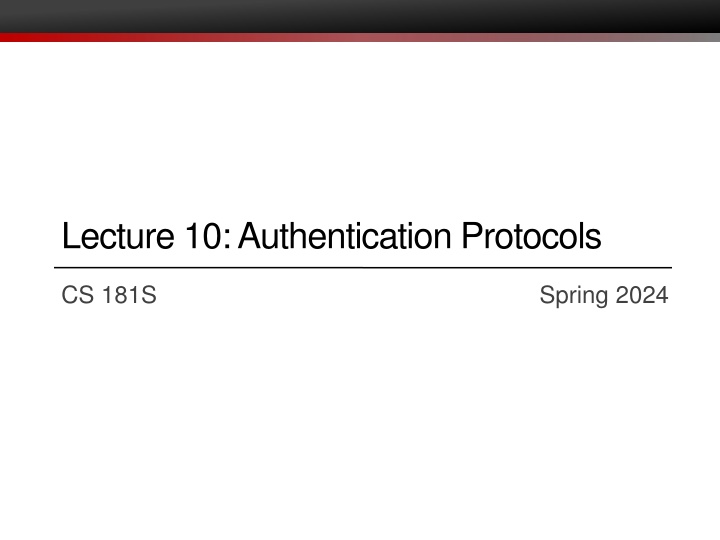
Authentication Protocols and Security Aspects
Explore the concepts of authentication protocols, security aspects, classes of principals, authentication threats, and countermeasures in network security, along with examples and countermeasures against vulnerabilities.
Download Presentation

Please find below an Image/Link to download the presentation.
The content on the website is provided AS IS for your information and personal use only. It may not be sold, licensed, or shared on other websites without obtaining consent from the author. If you encounter any issues during the download, it is possible that the publisher has removed the file from their server.
You are allowed to download the files provided on this website for personal or commercial use, subject to the condition that they are used lawfully. All files are the property of their respective owners.
The content on the website is provided AS IS for your information and personal use only. It may not be sold, licensed, or shared on other websites without obtaining consent from the author.
E N D
Presentation Transcript
Lecture 10: Authentication Protocols CS 181S Spring 2024
Aspects of Security Authentication: mechanisms that bind principals to actions Authorization: mechanisms that govern whether actions are permitted Audit: mechanisms that record and review actions
Aspects of Security Authentication: mechanisms that bind principals to actions Authorization: mechanisms that govern whether actions are permitted Audit: mechanisms that record and review actions ... Gold Standard [Lampson 2000]
Classes of Principals Authentication: mechanisms that bind principals to actions Authenticating Machines Authenticating Programs Authenticating Humans
Authentication Threat: attacker who controls the network Dolev-Yao model: attacker can read, modify, delete messages Vulnerability: communication channel between sender and receiver can be controlled by other principals Harm: attacker can pretend to have attributes they don't actually have (violating security goals) Countermeasure: authentication protocols
Authentication Protocols An authentication protocol allows a principal receiving a message to verify the identity of the principal that sent that message It's sunny in New York I prefer rain
Assumptions Assume Alice and Bob have a shared secret key k Assume that symmetric-key crypto works
Protocol 1 1. B -> A: B 2. A -> B: A, k
Defining Authentication A strong authentication protocol demonstrates knowledge of the secret without revealing the secret itself
Protocol 2 1. B -> A: B 2. A -> B: A, H(k)
Threat Model Dolev-Yao attacker controls the network, can read, modify, create packets A replay attack occurs when an adversary repeats (fragments of) a previous protocol run 1. B -> A: B 2. A -> B: A, H(k) B -> T: B T -> B: A, H(k) 1) 2)
Exercise: Replay Attacks Consider the following authentication protocol. Either demonstrate a replay attack against it or make an informal argument as to why it is secure against replay attacks. 1. B -> A: B 2. A -> B: A, Enc(AB; k) 1) B -> T: B 2) T -> B: A, Enc(AB; k)
Protocol 3 Idea: require Alice to authenticate with a different message every time 1. B -> A: B, r 2. A -> B: A, Enc(r;k) 1) B -> T: B, r2 2) T -> B: A, Enc(r; k)
Threat Model Dolev-Yao attacker controls the network, can read, modify, create packets A reflection attack occurs when an adversary sends messages from an ongoing protocol back to the originator 1. B -> T: B, r T -> B: A, r B -> T: B, Enc(r;k) 2. T -> B: A, Enc(r;k) 1) 2)
Exercise: Reflection Attacks Consider the following authentication protocol. Is this protocol vulnerable to a reflection attack? In each case, exhibit an attack or explain why it is not possible 1. B -> A: B, r 2. A -> B: A, Enc(A*B+r; k)
Exercise: Reflection Attacks Replay Attacks Reflection Attacks 1. B->T: B, r T->B: A, r B->T: B, Enc(B*A+r;k) 2. T->B: A,Enc(B*A+r;k) 1. B->A: B, r 2. A->B: A, Enc(A*B+r;k) B->T: B, r2 T->B: A, Enc(A*B+r;k) 1) 2) 1) 2)
Protocol 4: Multiple Keys Idea: have two different keys k_AB and k_BA for authenticating in the different directions 1. B -> A: B, r 2. A -> B: A, Enc(r;k_AB)
Protocol 5: Included Identity Idea: include the identity of the sender in the encrypted ciphertext 1. B -> A: B, r 2. A -> B: A, Enc(A, r; k)
Foiling Reflection Attacks Multiple Keys Included Identity 1. B->T: B, r T->B: A, r B->T: B, Enc(B, r; k) 2. T->B: A, Enc(B, r; k) 1. B->T: B, r T->B: A, r B->T: B, Enc(r;k_BA) 2. T->B: A, Enc(r;k_BA) 1) 1) 2) 2)
Exercise: Authentication Protocols Consider the following authentication protocols. For each: Is it vulnerable to a replay attack? Is this protocol vulnerable to a reflection attack? In each case, exhibit an attack or explain why it is not possible Protocol 1: 1. B -> A: B, r 2. A -> B: A, Enc(A B; k) Protocol 2: 1. B -> A: B, r 2. A -> B: A, Enc(A B + r; k) Protocol 3: 1. B -> A: B, r 2. A -> B: A, Enc(AB + r; k)
Threat Model Dolev-Yao attacker controls the network, can read, modify, create packets A man-in-the-middle attack occurs when an adversary secretly relays (and potentially changes) communications between two principals who believe they are communicating directly with eachother 1. B -> T: B, r T -> A: B, r A -> T: A, Enc(A, r; k) 2. T -> B: A, Enc(A, r;k) 1) 2)
Authentication Threat: attacker who controls the network Dolev-Yao model: attacker can read, modify, delete messages Vulnerability: communication channel between sender and receiver can be controlled by other principals Harm: attacker can pretend to have attributes they don't actually have (violating security goals) Countermeasure: authentication protocols
